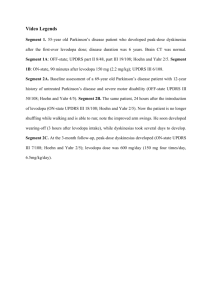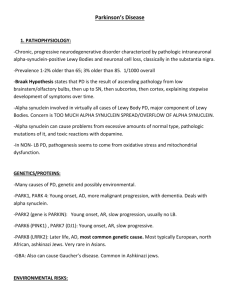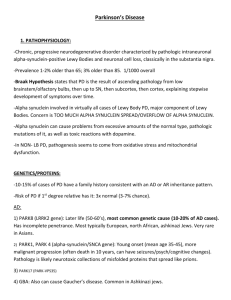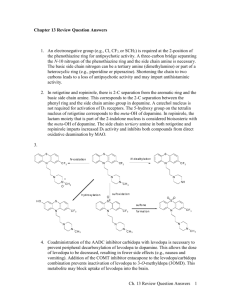Document 13306012
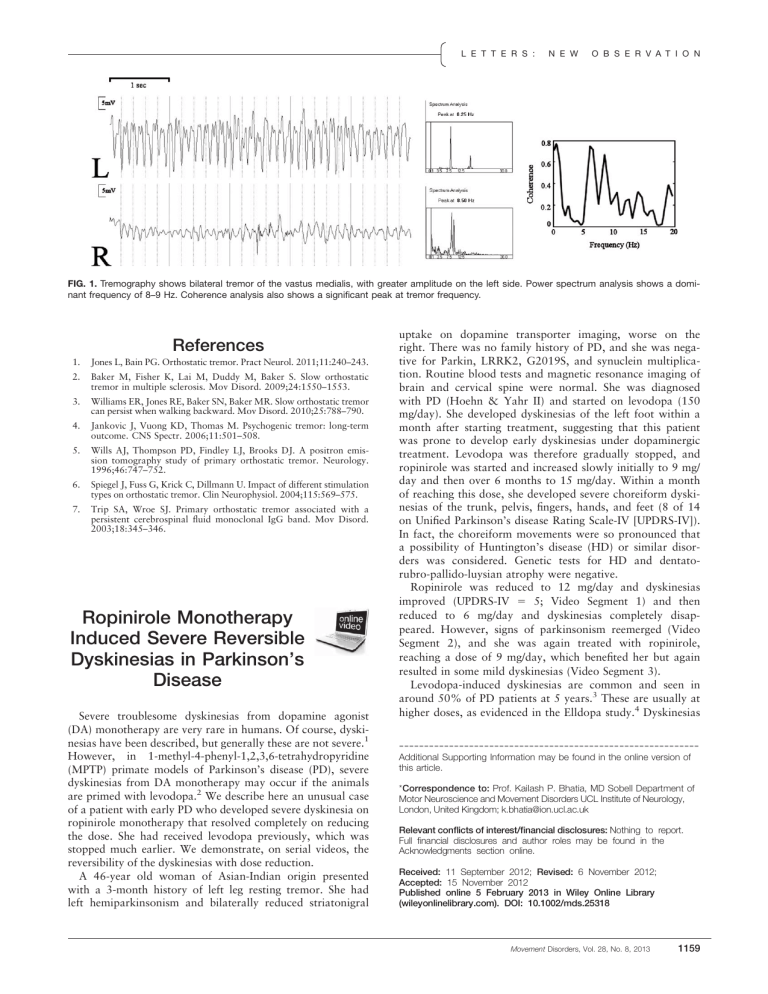
L E T T E R S : N E W O B S E R V A T I O N
FIG. 1.
Tremography shows bilateral tremor of the vastus medialis, with greater amplitude on the left side. Power spectrum analysis shows a dominant frequency of 8–9 Hz. Coherence analysis also shows a significant peak at tremor frequency.
References
1.
Jones L, Bain PG. Orthostatic tremor. Pract Neurol. 2011;11:240–243.
2.
Baker M, Fisher K, Lai M, Duddy M, Baker S. Slow orthostatic tremor in multiple sclerosis. Mov Disord. 2009;24:1550–1553.
3.
Williams ER, Jones RE, Baker SN, Baker MR. Slow orthostatic tremor can persist when walking backward. Mov Disord. 2010;25:788–790.
4.
Jankovic J, Vuong KD, Thomas M. Psychogenic tremor: long-term outcome. CNS Spectr. 2006;11:501–508.
5.
Wills AJ, Thompson PD, Findley LJ, Brooks DJ. A positron emission tomography study of primary orthostatic tremor. Neurology.
1996;46:747–752.
6.
Spiegel J, Fuss G, Krick C, Dillmann U. Impact of different stimulation types on orthostatic tremor. Clin Neurophysiol. 2004;115:569–575.
7.
Trip SA, Wroe SJ. Primary orthostatic tremor associated with a persistent cerebrospinal fluid monoclonal IgG band. Mov Disord.
2003;18:345–346.
Ropinirole Monotherapy
Induced Severe Reversible
Dyskinesias in Parkinson’s
Disease
Severe troublesome dyskinesias from dopamine agonist
(DA) monotherapy are very rare in humans. Of course, dyskinesias have been described, but generally these are not severe.
1
However, in 1-methyl-4-phenyl-1,2,3,6-tetrahydropyridine
(MPTP) primate models of Parkinson’s disease (PD), severe dyskinesias from DA monotherapy may occur if the animals are primed with levodopa.
2
We describe here an unusual case of a patient with early PD who developed severe dyskinesia on ropinirole monotherapy that resolved completely on reducing the dose. She had received levodopa previously, which was stopped much earlier. We demonstrate, on serial videos, the reversibility of the dyskinesias with dose reduction.
A 46-year old woman of Asian-Indian origin presented with a 3-month history of left leg resting tremor. She had left hemiparkinsonism and bilaterally reduced striatonigral uptake on dopamine transporter imaging, worse on the right. There was no family history of PD, and she was negative for Parkin, LRRK2, G2019S, and synuclein multiplication. Routine blood tests and magnetic resonance imaging of brain and cervical spine were normal. She was diagnosed with PD (Hoehn & Yahr II) and started on levodopa (150 mg/day). She developed dyskinesias of the left foot within a month after starting treatment, suggesting that this patient was prone to develop early dyskinesias under dopaminergic treatment. Levodopa was therefore gradually stopped, and ropinirole was started and increased slowly initially to 9 mg/ day and then over 6 months to 15 mg/day. Within a month of reaching this dose, she developed severe choreiform dyskinesias of the trunk, pelvis, fingers, hands, and feet (8 of 14 on Unified Parkinson’s disease Rating Scale-IV [UPDRS-IV]).
In fact, the choreiform movements were so pronounced that a possibility of Huntington’s disease (HD) or similar disorders was considered. Genetic tests for HD and dentatorubro-pallido-luysian atrophy were negative.
Ropinirole was reduced to 12 mg/day and dyskinesias improved (UPDRS-IV 5 5; Video Segment 1) and then reduced to 6 mg/day and dyskinesias completely disappeared. However, signs of parkinsonism reemerged (Video
Segment 2), and she was again treated with ropinirole, reaching a dose of 9 mg/day, which benefited her but again resulted in some mild dyskinesias (Video Segment 3).
Levodopa-induced dyskinesias are common and seen in around 50% of PD patients at 5 years.
3 These are usually at higher doses, as evidenced in the Elldopa study.
4
Dyskinesias
------------------------------------------------------------
Additional Supporting Information may be found in the online version of this article.
* Correspondence to: Prof. Kailash P. Bhatia, MD Sobell Department of
Motor Neuroscience and Movement Disorders UCL Institute of Neurology,
London, United Kingdom; k.bhatia@ion.ucl.ac.uk
Relevant conflicts of interest/financial disclosures: Nothing to report.
Full financial disclosures and author roles may be found in the
Acknowledgments section online.
Received: 11 September 2012; Revised: 6 November 2012;
Accepted: 15 November 2012
Published online 5 February 2013 in Wiley Online Library
(wileyonlinelibrary.com). DOI: 10.1002/mds.25318
Movement Disorders, Vol. 28, No. 8, 2013
1159
L E T T E R S : P U B L I S H E D A R T I C L E S developed in equal numbers of patients at 9 months (3.3%) in the 150 mg/day and placebo groups; however, they were significantly higher (16.5%) in 600 mg/day group. In contrast, dyskinesias with DA monotherapy are uncommon
(5%–7%), are milder in severity,
5 and appear much later
(mean, 8.6 years of treatment with or without levodopa) than levodopa-induced-dyskinesias.
6
Initial priming with levodopa may have contributed to the marked dyskinesias in this patient, similar to that seen in animal models of PD.
7
Reversibility has been described with dopamine agonist– induced axial dystonia,
8 but this has not been reported yet with dyskinesia.
Indeed, MPTP-treated marmosets, briefly primed with levodopa several months prior to DA introduction, developed dose-dependent dyskinesias with ropinirole. These were similar in type and severity to those induced by levodopa.
2 In contrast, in nonprimed animals, dyskinesias were seen in only 50%, were mild, and occurred at higher doses.
2 Upregulated opiate transmission has been seen in 6hydroxydopamine-lesioned rat models of levodopa-induceddyskinesia and may be one of the possible pathways for dyskinesia accentuated with levodopa priming.
9
Although marked dyskinesias are recognized in animal models, our case is unique as these have not been described in human patients on DA monotherapy. This case highlights that similar to animal models, some PD patients may develop marked dyskinesias with DA monotherapy when primed earlier with levodopa, even with a small dose for a short duration. It is possible that this particular patient may have developed dyskinesias on DA monotherapy even without levodopa priming, but this is speculative. Which PD patients are vulnerable to such DA-induced, levodopaprimed dyskinesias remains unanswered and may be established by larger cohort studies.
3
IRCCS Istituto Auxologico Italiano, Universita’ di Milano
Department of Neurology and Laboratory of Neuroscience,
Milan, Italy
4 Department of Clinical Neurosciences, UCL Institute of
Neurology London, United Kingdom
References
1.
Rascol O, Brooks DJ, Korczyn AD, DeDeyn PP, Clarke CE,
Lang AE. A five-year study of the incidence of dyskinesia in patients with early Parkinson’s disease who were treated with ropinirole or levodopa. 056 Study Group. N Engl J Med. 2000;342:
1484–1491.
2.
Pearce RK, Banerji T, Jenner P, Marsden CD. De novo administration of ropinirole and bromocriptine induces less dyskinesia than
L-dopa in the MPTP-treated marmoset. Mov Disord. 1998;13:
234–241.
3.
Kumar N, Van Gerpen JA, Bower JH, Ahlskog JE. Levodopa-dyskinesia incidence by age of Parkinson’s disease onset. Mov Disord.
2005;20:342–344.
4.
Fahn S, Oakes D, Shoulson I, et al. Levodopa and the progression of Parkinson’s disease. N Engl J Med. 2004;351:2498–2508.
5.
Lieberman A, Olanow CW, Sethi K, et al. A multicenter trial of ropinirole as adjunct treatment for Parkinson’s disease. Ropinirole
Study Group. Neurology. 1998;51:1057–1062.
6.
Hauser RA, Rascol O, Korczyn AD, et al. Ten-year follow-up of
Parkinson’s disease patients randomized to initial therapy with ropinirole or levodopa. Mov Disord. 2007;22:2409–2417.
7.
Nadjar A, Gerfen CR, Bezard E. Priming for l-dopa-induced dyskinesia in Parkinson’s disease: a feature inherent to the treatment or the disease? Prog Neurobiol. 2009;87:1–9.
8.
Cannas A, Solla P, Floris G, et al. Reversible Pisa syndrome in patients with Parkinson’s disease on dopaminergic therapy. J Neurol. 2009;256:390–395.
9.
Ravenscroft P, Chalon S, Brotchie JM, Crossman AR. Ropinirole versus L-DOPA effects on striatal opioid peptide precursors in a rodent model of Parkinson’s disease: implications for dyskinesia.
Exp Neurol. 2004;185:36–46.
Legend to the Video
Video Segment 1 (on 12 mg/day ropinirole). Moderate trunk and pelvic dyskinesias with choreiform dyskinesias in the hands and legs.
Video Segment 2 (on 6 mg/day ropinirole). Severe tremor and marked bradykinesia on the left side without dyskinesias.
Video Segment 3 (on 9 mg/day ropinirole). Mild dyskinesias and mild parkinsonian features with asymmetric bradykinesia.
“Occam’s Razor” and Identical
Twins With Discordant
Parkinson’s Disease
Entia non sunt multiplicanda praeter necessitatem (it is vain to do with many what can be done with few).
For many clinicians, it may be difficult to fully appreciate the practical and pathological significance of the tsunami of reported advances in genomics, obtained at
“visceral” expense.
1
It is salutary and refreshing to read a brief, illuminating, and potentially very significant short report
2 in which Xiromerisiou et al describe identical twins with leucine-rich repeat kinase type 2 mutations
Amit Batla, MD DM
1
Maria Stamelou, MD, PhD
1
Niccolo Mencacci, MD
2,3
Anthony H. Schapira, DSc, MD, FRCP, FMedSci
4
Kailash P. Bhatia, MD, FRCP
1*
1 Sobell Department of Motor Neuroscience and Movement
Disorders UCL Institute of Neurology, London, United
Kingdom
2
UCL Institute of Neurology, Department of Molecular
Neuroscience London, United Kingdom
------------------------------------------------------------
* Correspondence to: Dr. Gerald Stern, Emeritus Consultant Neurologist,
University College Hospitals, Queen Square, London WC1, United Kingdom; geraldsterniii@gmail.com
Relevant conflicts of interest/financial disclosures: Nothing to report.
Received: 14 May 2013; Accepted: 30 May 2013
Published online 00 Month 2013 in Wiley Online Library
(wileyonlinelibrary.com). DOI: 10.1002/mds.25597
1160
Movement Disorders, Vol. 28, No. 8, 2013
